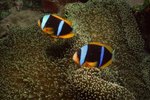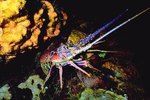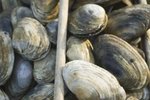The most likely clams to appear in the pet trade are the various species of giant clam, tridacnid clams. Although the biggest of these reaches several feet across, the smaller species, including Tridacna crocea and Tridacna maxima, are small enough to live in a home aquarium. As with all marine aquarium creatures, maintaining a giant clam is a serious commitment in terms of both time and money. If you just want an easy-to-care-for mollusk, a land snail would be a better choice. However, giant clams are far more colourful, and a serious hobbyist might find they make fascinating pets.
Step 1
Prepare your reef tank for the arrival of a clam before you bring the clam home. Aside from ensuring that the water parameters, including pH and temperature, are suitable for that particular species, you must also provide a strong light source if you don't already have one. Giant clams get much of their nutrition from symbiotic algae, which need sufficient light to photosynthesise. Without enough light, the clam will starve. Because clams are fairly immobile, not moving around much, it is necessary to also provide a secure surface, such as an arrangement of rocks, on which to position the clam. The stronger the light source, the deeper in the tank this spot can be.
Step 2
Confirm the species before buying the clam. Take along a reference book or printouts of an online reference. While smaller species reach only 6 to 12 inches across, truly giant species do appear for sale. These can reach 4 feet when mature, making them much too big for the average home aquarium. If you end up with one of these clams by accident, contact an aquarium club to locate a dedicated hobbyist with a big tank. Public aquariums in your area may be able to provide a home, although that's not guaranteed.
Step 3
Position the clam in your tank, using small rocks as necessary to wedge the shell. The mantle – the clam’s body where it emerges from the shell – should be facing up.
Step 4
Monitor nitrate and calcium levels in the tank, using test kits. Although nitrate levels should be nearly zero in most reefs tanks, giant clams require a small amount to sustain the algae in their bodies. Add a tiny amount of nitrate if levels are registering as nil, but don’t let levels climb above 2 parts per million. Calcium, required for shell building, should be about 380 to 450 parts per million. You can introduce extra calcium naturally, through adding items like coral to the tank, or more reliably with aquarium supplements.
Step 5
Feed the clam phytoplankton preparations as a supplemental food, especially if your tank does not contain a large number of fish. In heavily populated, well-established tanks, clams and their algae may get all the nutrients they need from the waste in the tank; but in a small home aquarium with few other creatures, they are at risk of going hungry.
References
Tips
- This is an introduction to the care of giant clams. It is not intended as a comprehensive guide. To find out the exact needs of your species, which vary from one to another, consult an online or print reference guide.
- If you are looking for a less demanding clam, some small species of freshwater clams do well in a freshwater tank.
Warnings
- As with other aquarium creatures, buy only captive-bred individuals. The aquarium trade in wild-caught fish and invertebrates causes serious conservation problems. These creatures may harbor diseases and parasites that could infect your other tank animals, not to mention that the stress of capture and transport means they might not live very long.
Writer Bio
Judith Willson has been writing since 2009, specializing in environmental and scientific topics. She has written content for school websites and worked for a Glasgow newspaper. Willson has a Master of Arts in English from the University of Aberdeen, Scotland.





